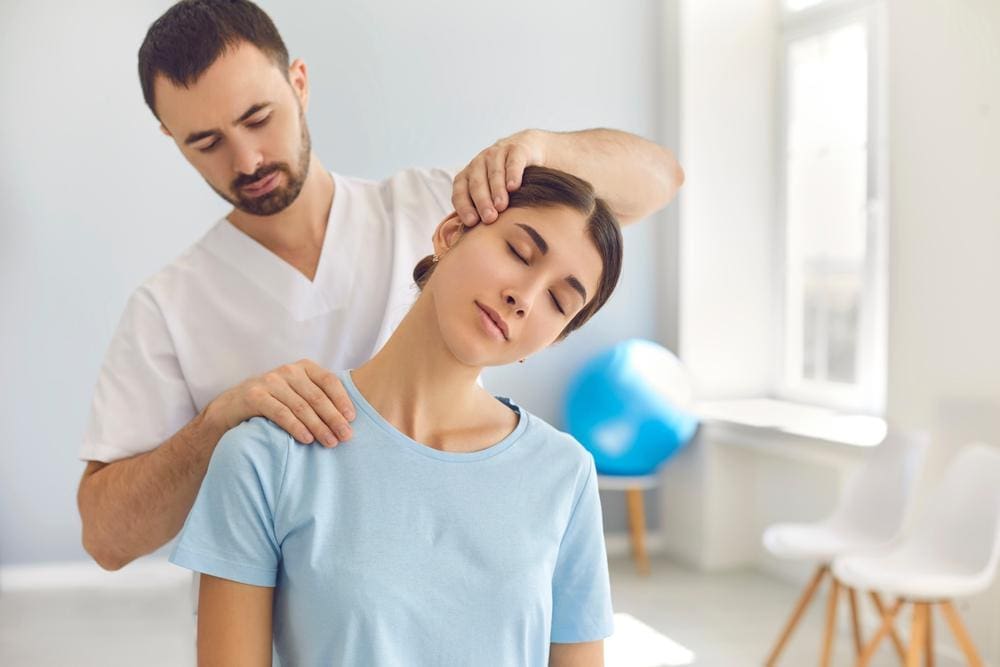
Chiropractic care for cervical dystonia is a safe, effective treatment for coping with the pain that comes with the disorder.
Cervical dystonia is a chronic disorder characterized by involuntary muscle contractions, or spasms, in the neck and shoulder muscles. These spasms can cause pain, make it difficult to move your head or shoulders, and lead to bad posture.
Cervical dystonia, also known as spasmodic torticollis, is a condition characterized by uncontrollable contractions or spasms in the neck muscles that cause involuntary and often painful twisting of the head to one side. Spasmodic torticollis involves the entire neck or certain portions, such as the chin, trunk, or shoulders.
Some people may experience mild discomfort in the neck triggered by specific activities like eating and drinking, while others experience severe pain and spasms which make it almost impossible to move their heads.
Spasmodic torticollis can also be associated with other neurological disorders such as Parkinson’s Disease, MS, and stroke. Cervical dystonia is the most common form of dystonia in which the muscles of the neck contract involuntarily, causing various abnormal postures and movements.
Cervical dystonia can affect people of any age. It’s most commonly diagnosed in middle-aged adults.
Cervical dystonia is a neurological disorder that causes involuntary spasms and contractions of the neck muscles. This can lead to abnormal postures such as the head dropping forward or tilting, torticollis (twisting of the neck), or even complete immobility.
These movements can be mild or severe to the point of causing severe pain.
Yes. Symptoms typically worsen gradually over time, but some treatments may help reduce symptoms and improve function. These treatments include medication, physical therapy, injections, and surgery. If you're experiencing symptoms of cervical dystonia, consult your doctor to discuss the best treatment options.
In most cases, cervical dystonia lasts for several years or longer before gradually subsiding on its own. However, some people have persistent symptoms that last their entire lifetime. It's difficult to determine the exact length of time someone can live with cervical dystonia since this condition is variable and different from person to person.
In general, most people with the condition experience a gradual improvement in their symptoms over several years. The severity and duration of cervical dystonia will also vary depending on factors such as age, overall health, and lifestyle habits.
Additionally, older adults are more likely to experience worsening symptoms over time, leading to difficulties performing everyday tasks and impacting their quality of life.
Historically, cervical dystonia was treated with general treatments for muscle spasms or contractions. However, medications such as anticholinergic drugs and benzodiazepines may provide only temporary symptomatic relief while the underlying condition worsens. Additionally, long-term use of these anti-spasm medications can lead to significant side effects.
More recently, a range of cervical dystonia treatments has been developed specifically to target the underlying cause of this condition and reduce abnormal muscle spasms.
These treatments include injections with botulinum toxin (commonly known as Botox) and surgical procedures such as deep brain stimulation or radiofrequency ablation. Injections with botulinum toxin are highly effective for most people with cervical dystonia and can significantly improve symptoms. Surgical procedures also show promising results, though they are typically recommended only after trying more conservative approaches such as injections with botulinum toxin.
While there are several different treatment options for cervical dystonia, one of the most effective is chiropractic treatment.
A chiropractor specializes in treating conditions that affect the musculoskeletal and nervous systems, which is why cervical dystonia is a good candidate for this type of treatment.

Many people who suffer from neck pain or tension headaches find relief through regular visits to a chiropractor because chiropractic treatment can relieve tension and help relax the affected muscles.
Chiropractic functional neurology is a chiropractic discipline that specializes in treating neurological conditions by restoring normal brain function rather than just alleviating symptoms. A functional neurologist relies on the unique skills that traditional neurologists bring to this condition (MRI scans, electroencephalograms) and combines those with specific chiropractic adjustments. One such adjustment is the Atlas Orthogonal (AO) technique, which has been used for over three decades to treat neurological conditions with great success.
While there are many types of functional neurologists, chiropractic functional neurology takes a unique approach that focuses on treating those with brain injuries, such as concussions and head trauma.
Chiropractic functional neurologists use chiropractic adjustment techniques to treat neurological symptoms that may include headaches, cognitive difficulties (e.g., memory loss or confusion), vision problems, dizziness or vertigo, seizures, and other conditions related directly to the nervous system.
Chiropractic treatment is often effective in relieving the painful muscle spasms and abnormal postures associated with cervical dystonia. By using spinal adjustments to improve the mobility of the joints, chiropractors enable patients to regain movement control. This can alleviate pain and help the patient to return to normal activities.

Evidence suggests chiropractic treatment can also help relieve secondary cervical dystonia symptoms, including headaches and elevated blood pressure. However, some patients may require periodic maintenance adjustments to maintain improvement over time.
There are many benefits to seeing a chiropractor for treatment of cervical dystonia.
One of the main benefits of seeing a chiropractor for treating cervical dystonia is that they have extensive knowledge and can help you find ways to reduce chronic pain, prevent symptoms, and improve your overall quality of life. Another benefit of seeing a chiropractor is that they can provide you with manual therapy, which can help ease inflammation. In addition, chiropractors are trained in techniques that can help release muscular tension in the neck and upper back areas.

© Accident Care Chiropractic | Hablamos Español
Located in: North Portland, NE Portland, SE Portland, Gresham, Clackamas, Oregon City, Hillsboro, Bethany, Beaverton, Tigard, Forest Grove, Woodburn,
McMinnville, Keizer, Salem, South Salem, Bend, Vancouver, Hazel Dell, East Vancouver, Pasco, Kennewick, Lakewood.
We Specialize in Car Accident Treatment & Recovery
Home | About Us | Testimonials | Blog | Sitemap | Privacy Policy | Services | Locations | Contact Us